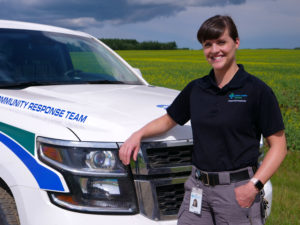New ways of providing care are needed to match the challenges of remote geographies. Rural service models might include resource-sharing with urban centres, increased use of technology, or new roles for health-care providers. Click the expandable menu below for articles about innovative ideas for improving service delivery in rural settings.
Health Services Models that Work for Rural Communities
Health services are more difficult and costly to deliver in rural areas, where populations are sparse with a greater distance between them. Models of care in rural and remote areas must differ from those in urban communities using strategies unique to the rural context.
Also, medical care has shifted to a greater focus on community-based care and more up-stream population health and early interventions such as screening, health teaching, family planning, or injury prevention. This has made way for new service delivery models closer to home that better meet the needs of rural communities.
Several service delivery models are common in rural areas, such as:
- local and regional integrated services
- outreach services
- mobile services
- virtual health services.
These models can improve health care access, continuity of care, and the quality of service delivery in rural areas. Below you find a description of each of these service models with some rural examples.
Local integration: one-stop shops
Integrated health models are located within local communities and offer a range of services. The most common example is the community health centre, where health providers from different backgrounds work together to offer the services. These centres are often referred to as “one stop health shops”. Services may include primary clinical care, preventive and health promotion activity, as well as education. For two great Alberta examples, check out the Slave Lake Family Care Clinic and the Vulcan Community Health Centre.
Integrated local services aim to improve health outcomes through better access to services and by addressing underlying social determinants of health. They also direct people to the most appropriate form of care and avoid costly duplication. Apart from offering convenient access, health centres may help to de-stigmatized some services (e.g. sexual health, mental health) as they are included as part of the general health service. Integrated health services fit in with the modern emphasis on primary and preventive care.
Regional integration: health networks and integrated care pathways
Another form of an integrated service model is a rural health network. Different from local community health centres, rural health networks are designed to achieving larger-scale, region-wide integration. Integration can occur between different kinds of providers, such as a primary care practice and a geriatric (seniors) health team, or between different levels of services, such as a rural hospital and an urban hospital or specialist care services.

Rural health networks allow sharing of resources and the provision of specialist services that individual communities could not support by themselves. Most importantly, networks allow the formation of an “integrated care pathway”, which is a well-defined approach to delivering all necessary services to a population, irrespective of their location.
An integrated pathway describes the route that a patient will take from their first contact with their primary care provider to a transfer to the hospital for specialized care. It also covers the period from hospital admission to discharge back home for follow-up care.
The Specialist Link, Alberta Health Services describes care pathways for different conditions. These integrated care pathways ensure that Albertans have timely access to specialist and hospital care, no matter where they live.
Outreach services
Outreach models offer periodic services from one location which has services to other locations which do not. They often use a “hub and spoke” approach where the main service or clinic is centrally located but will visit satellite communities on a regular basis. For example, a general practitioner residing in one community may visit a second community for short periods, or services are supplied on a fly-in fly-out basis.

Specialist outreach models are also emerging. They are often part of multifaceted interventions involving collaboration with primary care, education or other services. For example, Extension for Community Healthcare Outcomes (ECHO) is a unique “hub and spoke” model where rural practitioners can work with and learn from academic specialists using video conferencing. The use of outreach models is associated with improved health outcomes, more efficient and guideline consistent care, and less use of inpatient services.

Mobile health services
Mobile health services bring services, including specialist equipment, to rural communities through mobile units, such as a health bus or mobile clinic.
Mobile mammogram and prostate cancer screening services are two examples. These mobile services travel through the province according to posted schedules. They bring health services out of the medical, “institutional” setting into one that may be more attractive to populations that do not typically access regular preventive health care checks and tests. Mobile services may overcome a variety of barriers to access of health services, including distance, social isolation, lack of time, and cultural issues.
Despite improved access offered by mobile services, they may be less acceptable to consumers who prefer local, fixed services. Many mobile services operate as projects or pilots, which may have difficulty getting ongoing funding and providing continuity of care. Due to their periodic nature, mobile services may not be available when most needed.
Virtual health services
Virtual health services, also called virtual care, is a broad term that describes the use of information and communication technologies to provide health care to patients when the health provider and patient are not in the same location. One example is real-time virtual visits between patients and health providers using videoconferencing and mobile apps. Alberta Health Services has a comprehensive Telehealth program that supports 37 clinical programs.
Virtual health has been on the rise over the past decade as a means of overcoming problems of access to health care and the shortage of health professionals in rural and remote areas. In many cases, virtual health is used to augment other service delivery models.
Because virtual health is so important for rural communities, we have dedicated an entire section to this topic.



